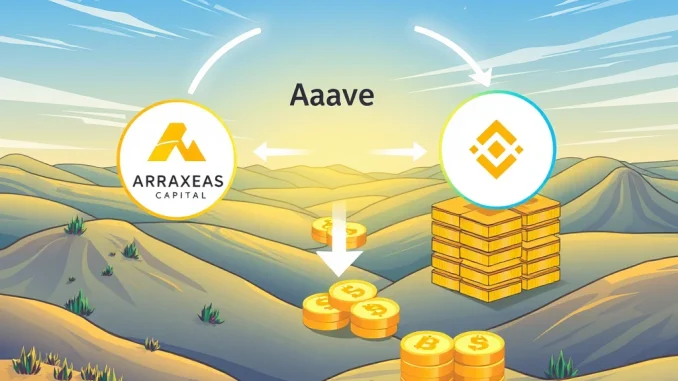
Big moves are happening in the crypto world, and institutional players are often at the center. Recently, attention turned to Abraxas Capital following a significant USDT deposit into Binance.
What Triggered the $240M USDT Deposit?
According to on-chain data shared by Lookonchain, London-based investment manager Abraxas Capital executed a substantial financial maneuver. Over a 24-hour period, the firm deposited a total of 240 million USDT onto the Binance Exchange.
What makes this transaction particularly interesting is the source of the funds. The 240 million USDT was reportedly borrowed from Aave, a prominent DeFi lending protocol. This strategy of borrowing from DeFi platforms to fund activities on centralized exchanges (CEXs) highlights the increasing interplay between these two distinct sectors of the crypto ecosystem.
Key details:
- **Entity:** Abraxas Capital (Investment Manager)
- **Amount:** 240 million USDT
- **Destination:** Binance Exchange
- **Source:** Borrowed from Aave (DeFi Lending Protocol)
Why Would Abraxas Capital Borrow from Aave for a Binance USDT Deposit?
This kind of large-scale movement suggests strategic intent. While the exact reasons remain speculative, several possibilities could explain why Abraxas Capital chose to borrow 240 million USDT from Aave and deposit it onto Binance:
1. **Arbitrage Opportunities:** The firm might be positioning itself to capitalize on price differences for various assets between the Aave ecosystem (or other DeFi protocols) and the Binance trading platform. Borrowing USDT allows them to quickly access stablecoin liquidity without selling existing assets.
2. **Trading or Market Making:** A large USDT deposit provides significant liquidity for trading pairs on Binance. Abraxas Capital could be planning extensive trading activities, potentially involving spot trading, futures, or options, or acting as a market maker to profit from bid-ask spreads.
3. **Yield Farming or Staking on Binance:** While Aave itself offers lending yields, Binance also provides various yield-generating products, including staking, savings, or specific DeFi-like pools within its platform. The firm might have identified a potentially higher or more suitable yield opportunity on Binance.
4. **Collateral Management:** The borrowing from Aave would likely require collateral. Managing this collateral position while utilizing the borrowed funds on a CEX like Binance requires careful strategy, potentially aiming to optimize capital efficiency or manage risk across platforms.
The scale of the 240 million USDT deposit indicates a high-conviction trade or strategy being implemented by Abraxas Capital.
What Does This Abraxas Capital Move Signify?
This event underscores several trends in the current crypto landscape:
- **Institutional Adoption:** It shows sophisticated investment firms like Abraxas Capital are actively using both DeFi protocols (Aave) and major centralized exchanges (Binance) in complex financial strategies.
- **DeFi-CEX Interoperability:** The seamless movement of funds between DeFi lending platforms and CEX trading venues highlights the increasing integration and flow of capital between these sectors.
- **Liquidity Positioning:** Large stablecoin deposits on exchanges are often precursors to significant trading activity, suggesting Abraxas Capital is preparing for market participation on Binance.
Monitoring such large transactions, particularly those involving prominent firms and significant amounts of USDT, provides insight into potential market movements or strategic positioning by major players.
In Conclusion: A Strategic USDT Deposit
Abraxas Capital’s deposit of 240 million USDT into Binance, sourced from a borrow on Aave, is a notable event. It points to a deliberate, large-scale strategy by the investment manager, likely related to trading, market making, or yield optimization across different crypto platforms. This move further emphasizes the dynamic and increasingly interconnected nature of the DeFi and centralized exchange landscapes as institutional participants become more active.



